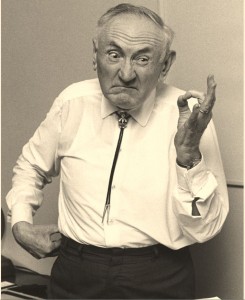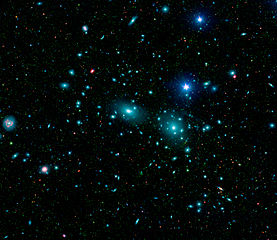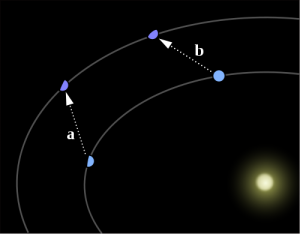May 14, 2012
Dark Matter – A Two-Handed Discussion
Dr Stuart Clark and Dr Chris Lintott
Report by: Judith-Anne MacKenzie (edited by Chris Sutcliffe and Mike Meynell)
In front of a packed audience, we were delighted to welcome back two old friends of the society, Dr Chris Lintott and Dr Stuart Clark, for a debate on Dark Matter. Dr Marek Kukula of the Royal Observatory Greenwich, in his second consecutive Flamsteed appearance, chaired the debate.
Setting the Scene
We started with Stuart giving a history of dark matter going back to Fritz Zwicky in the 1930s. Stuart explained that the dark matter debate was just the latest round of discussions that have driven astronomy from its beginning… trying to understand the way things move, and why they move. Every time we make a breakthrough in our understanding, the universe opens up before us in a whole new way. Stuart emphasised that there is no more important investigation in astronomy, or maybe even in the whole of science, at present.
Zwicky was studying the Coma Cluster of galaxies in the 1930s. These are vast galaxies, each containing over 100 billion stars, which are gravitationally bound together around a common centre of gravity. Zwicky discovered that the galaxies were moving much faster than expected, based on the amount of mass that was visible, meaning that (based on our expectations of Newtonian gravity) there must be a very large amount of ‘invisible’ matter present. Zwicky coined the phrase ‘dark matter’ to explain this apparent missing mass. In the 1970s, it was discovered that stars on the outer edges of galaxies were also moving too fast based on the amount of visible matter. The crux of the debate, therefore, is how to explain the movement of galaxies and stars… is there ‘invisible’ or ‘dark’ matter, or do we need to modify our theory of gravity to explain this movement?
|
|
Chris agreed that the debate was one of motions that we do not understand. He explained that the discovery of Neptune was essentially a solution to a dark matter problem, as astronomers observed that Uranus was moving in a way that could not be understood without the presence of more matter. We are ‘celestial magpies’ when we look at the universe, concentrating on the stuff that shines. However, looking at our own galaxy, the galaxy’s disc is where most of the stars lie, but the Milky Way itself sits in a much larger halo of matter. So could the missing mass be living out in the halo? One theory was to postulate the existence of ‘Jupiter-sized’ bodies… stuff that never condensed into stars… known as ‘MACHOs’ (Massive Compact Halo Objects). Astronomers were able to test this theory by looking at stars in our companion galaxies… the Large and Small Magellanic Clouds… and observing how many stars in these galaxies would ‘blink’ due to the gravitational lensing effect of bodies passing between the star and the observer. It was found that not nearly enough matter could be accounted for, so the theory of MACHOs was dead by the 1990s.
So, if not in the form of MACHOs, could the mass exist in the form of dust and gas? Stuart did not believe it could be. Observations of the microwave background radiation suggests that there doesn’t appear to be much more atomic matter in the universe than we can see in stars. At most, you could perhaps find about twice the number that we already know exists, which would mostly be found in the warm-hot intergalactic medium (WHIM), which radiates at ultra-violet wavelengths. Unfortunately, as we have no ultra-violet space telescopes at present, this is difficult to see.
Chris then discussed the concept of Weakly Interacting Massive Particles (WIMPs). He explained that it is not unusual to find or predict new particles… this is being done at CERN (the world’s largest particle physics laboratory) all the time. To explain the missing mass, you would need a large particle, perhaps about the size of a copper atom, which is neutral and doesn’t interact with light. If we make the universe mostly out of this very heavy neutron, then we solve the dark matter problem. Computer simulations have been created using the physics of this dark matter particle, which closely resemble which the universe that we see today. The simulations are very sensitive to the amount and type of dark matter… too much gives a universe that is too ‘clumpy’… too little gives a ‘smooth’ universe that doesn’t look like the universe we can observe.
Stuart showed a slide of NGC 1560, which is an edge-on spiral galaxy. This galaxy is a poster-child for a different way of solving the rotation curve issue, as dark matter within a spherical halo around the galaxy cannot fully explain the rotation curve. A theory known as MOND (Modified Newtonian Dynamics) suggests that, in areas of very weak gravitational fields, gravity acts more like a constant force rather than the inverse-square drop-off that Newton says it should. If you apply MOND to the galaxy rotation curve, everything seems to work. However, MOND was only ever meant to provide an empirical fit to the data. We don’t know where this comes from in theory. Stuart discussed the problem with the movement of Mercury. Newtonian theory could not predict the motion of Mercury, leading to speculation that another planet existed. It took Einstein’s General Relativity, which effectively modified how gravity worked in strong gravitational fields, to explain.
The Debate
Marek summarised by stating that there’s something that doesn’t make sense about the way things move in the universe. Either that means that there’s more stuff there than we can see, or possibly it means that we don’t understand gravity properly. Marek asked what the ‘stuff’ could be made of.
Chris stated that dark matter particles do not attract each other very strongly. There must be some new force that we don’t understand; otherwise it would clump into planets, which has been discounted by observation. It must exist everywhere with particles passing through us all the time. This is OK as dark matter does not react with normal matter very much.
Marek asked Stuart about the nature of gravity. What is it and what don’t we understand about it? Stuart stated that the gravitational changes required by MOND are so weak that we cannot reproduce them on Earth. They are the kind of gravitational fields that would be generated by a single sheet of A4 paper in empty space. MOND puts the extra gravitational power where it’s needed, in weak field regimes. Dark matter solutions put more power everywhere, in the centres of galaxies as well as in galactic halo, so you have to fine-tune each of the dark matter halos in order to match the rotation curves. This highlights the key difference between dark matter and MOND.
Chris countered that we’ve got observations on many different scales, not just on the scale of galactic discs. For example, on the scale of galaxy clusters we have the Bullet Cluster, which is an edge on collision of two giant galaxy clusters. Using gravitational lensing, we’ve found that most of the mass of these clusters is still in the outskirts of the clusters. MOND alone cannot explain this and even proponents of MOND state that there must be some form of dark matter to explain this.
Stuart argued that this weak gravitational lensing distortion could be explained by MOND pulling a little more strongly in these weak gravitational regimes than Newton’s gravity does. This would translate into more curvature for the underlying fabric of space than you thought was there. Although it was true that the Bullet Cluster could not be explained without some extra mass, the amount of additional mass is about twice what you see in the visible regimes. Stuart postulated that this could be due to neutrinos, if we assumed that neutrinos have a reasonably high mass. He also stated that observations of the Bullet Cluster are not replicated in other cluster collisions.
Chris refuted that it is not just the Bullet Cluster. Observations of two pulsars (see Shklovskii effect: http://arxiv.org/pdf/1205.1450.pdf) show that the kind of curvature you need to explain the Bullet Cluster results, or cluster scale activity, would have a dramatic effect on these pulsars that definitively rule out some versions of MOND theory.
Stuart said that the Bullet Cluster is not in a relativistic regime, whereas, in the case of the double pulsar, you do need relativity, given the strong gravitational field. MOND is non-relativistic ‘fit’. It modifies Newton’s gravity, not Einstein’s gravity. With MOND, we are missing an overarching theory. One possible theory was TeVeS (Tensor-Vector-Scalar theory), which has been disproved with the double pulsar observations. However, this does not touch the phenomenology of MOND in the spiral galaxies or MOND in the Bullet Cluster and the non-relativistic regimes. In fact, the double pulsar observations also show that the equivalence principle (inertial mass equalling gravitational mass) still stands, which gives many dark matter theories a problem, as they require the equivalence principle to be broken at some level. Therefore both MOND and dark matter encounter problems with these observations.
Marek asked about the nature of dark matter. Chris stated that it must be a massive neutral particle. There are various detectors at CERN, such as the ATLAS detector, which may find a dark matter candidate particle. However, this will not solve the dark matter problem. We have to show that they are there in the universe. There are various detector experiments looking for evidence of these particles. Some experiments seem to provide evidence, but this is not conclusive.
Stuart stated that some of these experiments produce contradictory results. Although Chris agreed, he said that we shouldn’t rule out the whole theory, it may just be that we don’t understand the particle physics yet. Stuart said that there is no astronomical observation that indicates that the answer must be particles. Chris countered with an argument on the Cosmic Microwave Background, stating that current observations support the particle nature of dark matter. Apparently, the European Space Agency’s Planck mission will provide more accurate measurements in January 2013.
The debate then turned to Dwarf Spheroidal galaxies. Chris stated that MOND couldn’t explain these small dwarf spheroidals. Also, dark matter theory predicted the existence of little dwarf galaxies in our local neighbourhood, which have now been found through observations. Chris believed that this was one of the greatest triumphs of the dark matter theory. Stuart said that not nearly enough dwarf galaxies had been found to fit dark matter theory. It was possible that dwarf galaxies had been created through ‘tidal’ processes as a result of the collision of larger galaxies. This would result in dwarf galaxies that are not dark matter dominated. However, observation suggests that these galaxies are loaded with dark matter. An alternative explanation would be that, because the galaxies are so low density, they are in the MONDian regime.
Marek wondered if it was too early to be having this debate. We only posited the existence of dark energy 14 years ago. Chris agreed that, presently, we don’t have a clue about dark energy. It’s a theorist’s problem and we don’t even know what observations to do. Stuart thought that there was no reason not to attack the problem of dark matter now. Dark energy itself is entirely overwhelmed by just the gravity we know of within the realms of galaxies and within the realms of galaxy clusters. Stuart believed that the debate comes down to misunderstanding gravity, but if a particle were found that fitted the galaxy rotation curves perfectly, then he would support that.
The Vote
Marek then took some questions from the audience, followed by a vote on whether the answer to the rotation curve problem was dark matter or MOND. The majority of Flamsteed members voted for MOND, although there were a number of abstentions. Marek then put an alternative theory to a vote… that we need to look at the universe in a slightly different way… maybe there is new physics out there to discover. This option gained considerable support from the audience.
A truly superb evening of entertainment was then brought to an end, with all Flamsteed members much appreciative of the high quality of the debate.
Posted under: Flamsteed, Flamsteed Lecture, Meeting Report
























You must be logged in to post a comment.